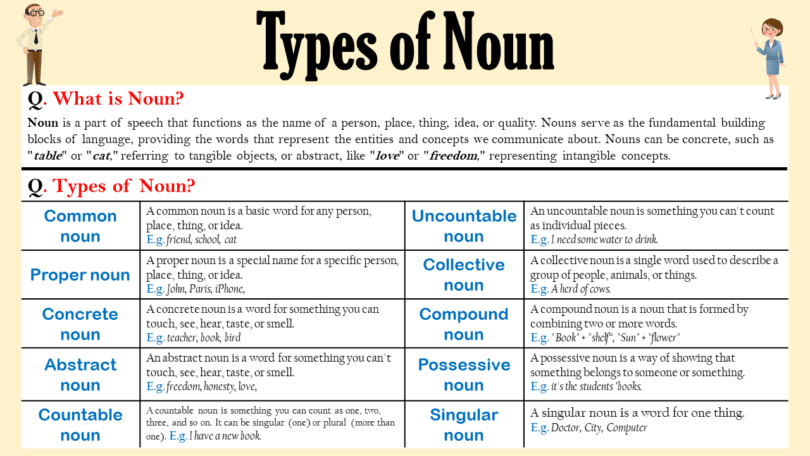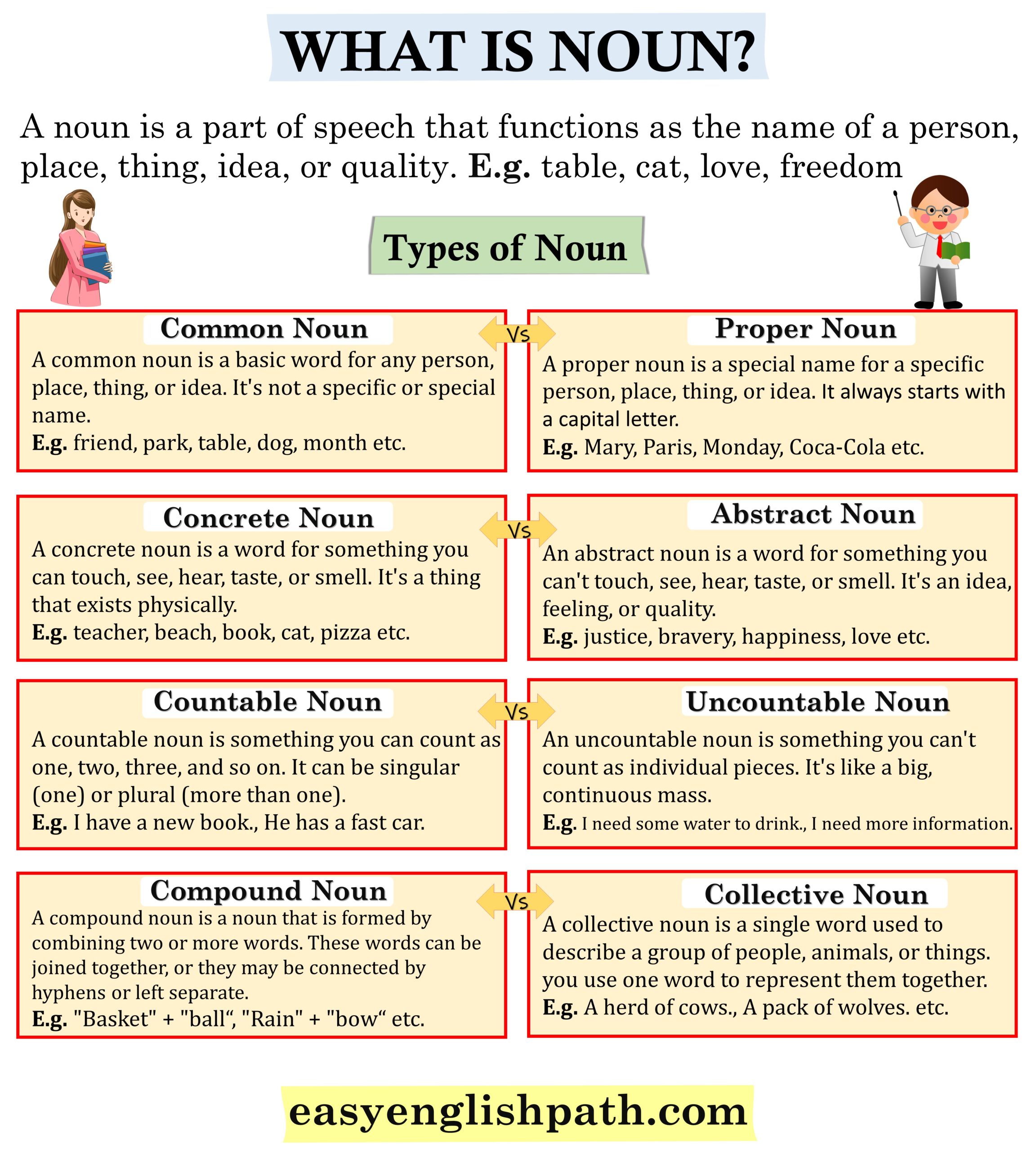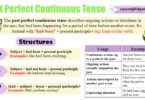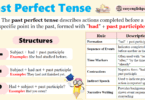What is Noun?
A noun is a word that names a person, place, thing, or idea. It’s any word you can put a or the in front of. For example, dog, Paris, and happiness ‘are all nouns because they name a specific thing, place, or concept. Nouns help us communicate by giving names to everything around us.
| Category | Examples |
|---|---|
| Things | ball, toy, bike, chair, book |
| People and Pets | mom, friend, cat, teacher, baby |
| Places | park, school, beach, home, store |
| Ideas and Feelings | love, fun, kindness, anger, playfulness |
| Groups | family, team, class, band, club |
| Actions | jump, dance, eat, read, sleep |
| Materials | paper, wood, metal, water, plastic |
| Time | day, week, moment, morning, year |
How are Nouns Used in sentences?
Subject Nouns:
Nouns often function as the subject of a sentence, that represents the person, place, thing, or idea that performs the action.
- Dogs bark loudly.
- John is a talented musician.
- Cats are drinking milk.
- Burj khalifa is a famous place.
Object Nouns:
Nouns can also function as objects within a sentence, either as direct objects or indirect objects:
Direct Object: I enjoy reading books.
Indirect Object: She gave me a gift.
Object of Prepositions:
Nouns frequently follow prepositions in a sentence, they act as the object of the preposition.
- The cat is sitting on the mat.”
- She is interested in science.”
Noun Complements:
Nouns can function as complements, completing the meaning of a sentence. This often occurs with linking verbs.
- She became a lawyer.
- The winner is John.
Direct Address:
Nouns can be used in a sentence to directly address someone or something
- Please pass the salt, Alice.
- Oh, Nature, you are magnificent!
Gerunds:
Nouns can be formed from verbs by adding the “-ing” suffix, creating gerunds
- Swimming is my favorite activity.
- I enjoy reading.”
Noun Clauses:
Nouns can function as the subject or object of a clause
- What she said is true
- I understand that you are busy.”
Types of Nouns
1. Common Noun:
- The dog chased the cat.
- She read a book under the tree.
- He visited the park with his friends.
2. Proper Noun:
Proper nouns are words that we use to talk about specific people, places, or things. They always start with a capital letter, like names of people, cities, or companies. For example, “John,” “Paris,” and “Google” are all proper nouns because they refer to specific individuals, locations, or organizations.
- John went to New York for vacation.
- Alice works at Microsoft.
- We visited Mount Everest during our trip to Nepal.
3. Concrete Noun:
- The table is made of wood.
- The dog chased the ball.
- She picked a beautiful flower from the garden.
4. Abstract Noun:
Abstract nouns are words that represent ideas, feelings, qualities, or states that we can’t touch or see physically. They’re things we can’t experience with our senses, but we understand them because they’re concepts.
- Her kindness touched everyone around her.
- The beauty of the sunset was breathtaking.
- He felt a sense of freedom as he explored the open road.
5. Countable Noun:
Countable nouns are the names we use for things that we can count as individual units. We can use numbers with countable nouns, like one, two, three, etc.
- I have two cats.
- She bought three books.
- He owns five cars.
6. Uncountable Noun:
Uncountable nouns are the names we use for things that we can’t count as individual units. They are usually substances, concepts, or qualities that are considered whole or continuous.
- She drank some water.
- He enjoys listening to music.
- They need to buy some furniture for their new house.
7. Collective Noun:
A collective noun is a single word that is used to describe a group of people, animals, or things. Instead of naming each one separately, you use one word to represent them together.
- The team is practicing for the championship.
- A flock of birds flew overhead.
- The band played at the concert last night.
8. Compound Noun:
Compound nouns are formed by combining two or more words to create a new, These words can be joined together, or they may be connected by hyphens or left separate.
- She bought a toothbrush from the store.
- We played basketball at the park.
- The garden was full of beautiful sunflowers.
9. Possessive Noun:
Possessive nouns are used to show ownership or possession. They indicate that something belongs to someone or something else. Here are three example sentences:
- That is Sarah’s book.
- The cat’s tail is fluffy.
- I borrowed John’s car for the weekend.
10. Plural Noun:
Rules of Noun
| Rule | Description | Examples |
|---|---|---|
| 1 | General names for people, places, things, or ideas. | boy, city, book |
| 2 | Specific names for individual people, places, or things, always capitalized. | John, London, Coca-Cola |
| 3 | Refer to items that can be counted as individual units and have both singular and plural forms. | cat/cats, chair/chairs |
| 4 | Denote substances, concepts, or things that cannot be counted as separate units and usually lack a plural form. | water, happiness, information |
| 5 | Tangible, physical objects that can be perceived through the senses. | table, tree, music instrument |
| 6 | Intangible concepts, feelings, qualities, or ideas that cannot be perceived through the senses. | love, democracy, courage |
| 7 | Refer to groups or collections of people, animals, or things. | team, family, flock |
| 8 | Formed by combining two or more words to create a new, single entity with a specific meaning. | toothbrush, basketball, sunflower |
| 9 | Indicate ownership or possession and are formed by adding an apostrophe and ‘s’ to the noun. | the cat’s tail, Sarah’s car |
| 10 | Used when referring to more than one person, place, thing, or idea, typically formed by adding ‘-s’ or ‘-es’ to the singular form. | dogs, cities, books |
You May Also Like






